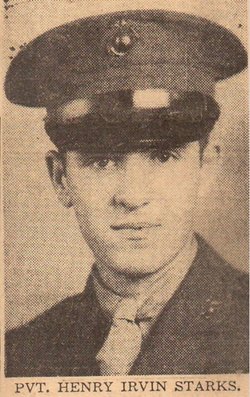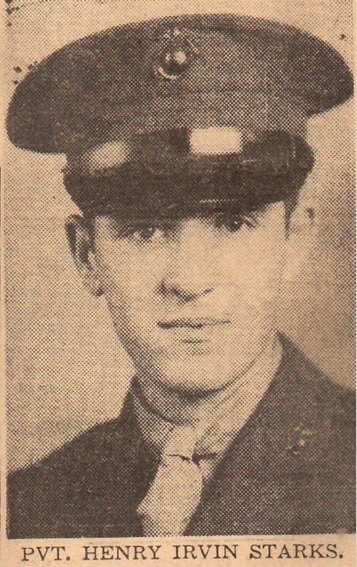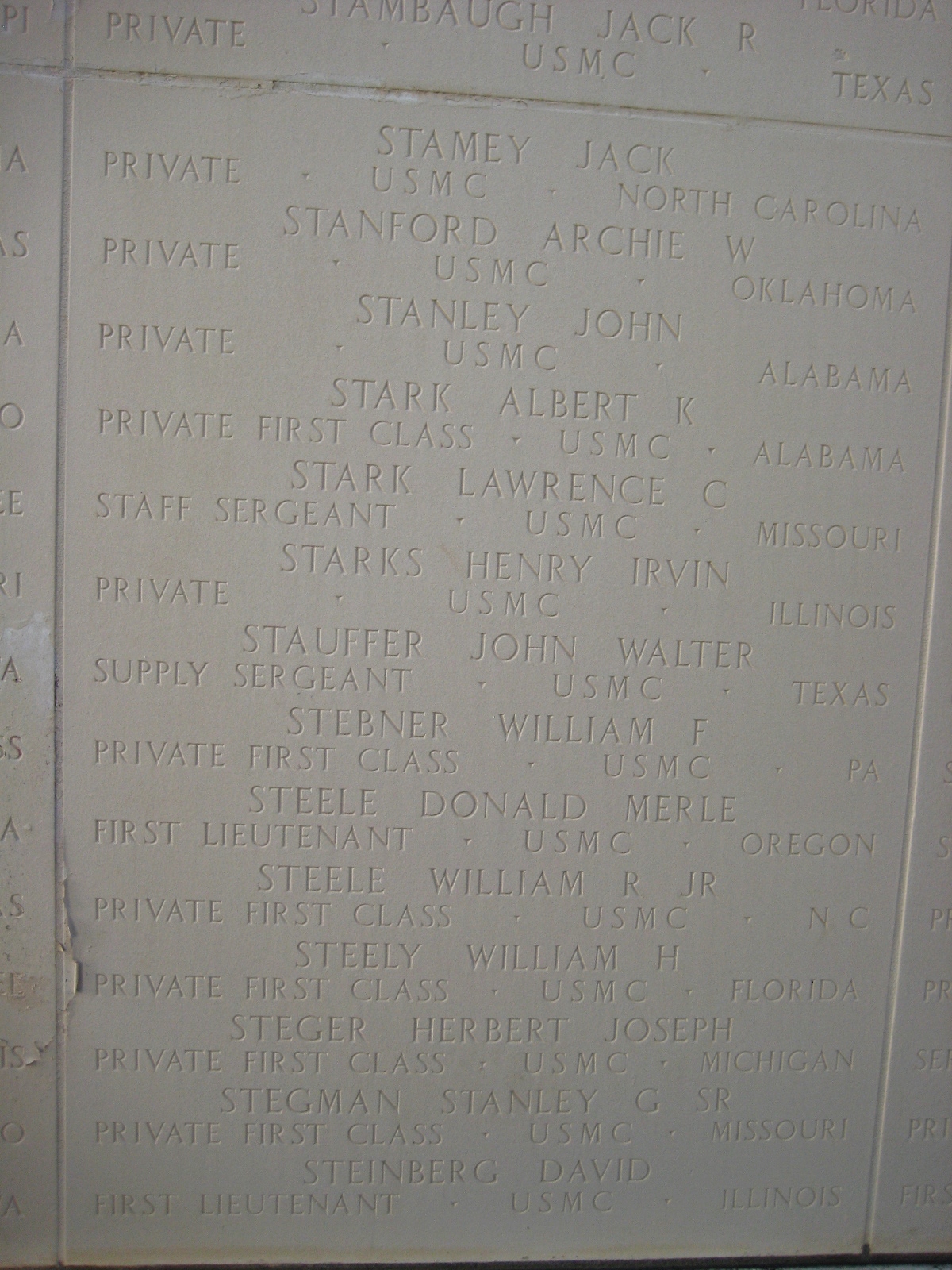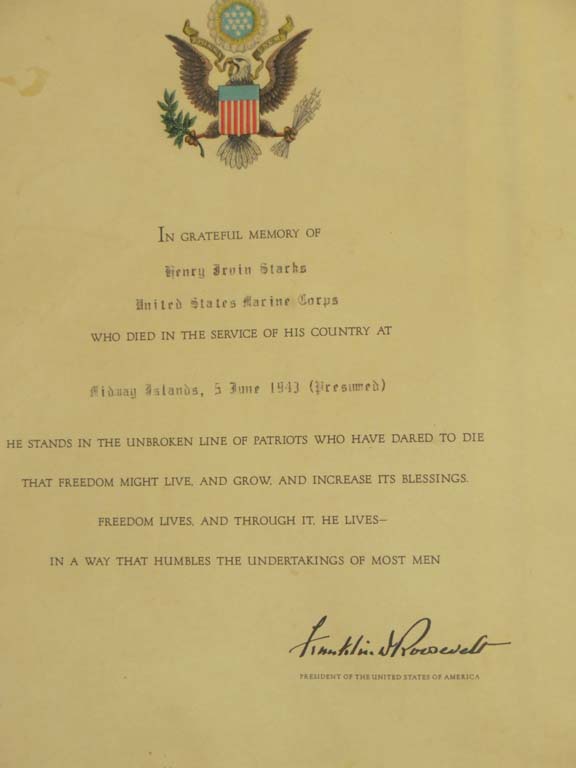Starks enlisted in the United States Marine Corps on September 1, 1941. After completing boot camp at the Marine Corps Recruit Depot at San Diego, California, he received additional training in aviation maintenance. Upon completion of this course, Starks was given orders to ship out to Midway Island on May 26, 1942 via the USS KITTY HAWK Aircraft Carrier. He reported for duty with the ground echelon of VMSB-241. Starks would work on an old Vought SB2U Vindicator, an obsolete bomber that, until this date, had been the only type of aircraft available to the squadron. When he had arrived at Midway, a group of nineteen new Douglas Dauntless SBD-2 dive bombers had also arrived but he was not fortunate enough to have been assigned to them. The old Vindicators were to be manned by less experienced pilots (some of whom had arrived with Starks) in a separate section of the squadron, under Major Benjamin Norris.
Colonel Ira Kimes, the commander of MAG-22, found that he was short of gunners for the Vindicator group. Lacking alternatives, he turned to his mechanics for volunteers and Starks was one of those to step forward to fill one of those positions. It is unknown why Starks chose to volunteer; perhaps he wanted to do his part in the coming battle, or perhaps he was simply nineteen and thought himself invincible as many young Marines tend to do.
Starks was assigned to the Vindicator flown by Second Lieutenant Daniel Cummings, a fighter pilot who had transferred from VMF-221 a few days earlier on May 27th. While he did get some training on the ground firing a .30 caliber machine-gun, there was neither time, ammunition, or resources available for him to train in the air. Before taking off for his first and only combat mission, Starks had logged exactly three flights in his Vindicator before flying off to his destiny.
Lt Cummings wrote in an After-Action Report on June 7, 1942, the following statement:
"On the morning of June 4, 1942, after an air raid alarm I took off and rendezvoused with my division twenty miles east of Midway Island. At this time our island base was attacked and we could see columns of smoke rising above it. On the radio I heard the order for Major Norris to attacked [sic] a carrier and in a few minutes we headed towards our target. Just before we got there I saw an enemy Zero fighter. After he had made the first pass on the tail of our formation, and I was holding the last position, I heard no more from my rear seat gunner. I believe that he was killed at this time. I might add here that Starks, my gunner, had never before fired a machine gun in the air and could not be expected to be an effective shot much less protect himself. From that point on, I had no rear seat protection."
Cummings dove on the battleship HARUNA, but could not engage the might ship and diverted his attack to a Japanese destroyer. According to his report, for fifteen minutes Lt. Cummings put the Vindicator through every maneuver he could think of to throw off the Japanese Zeros. Finally, he made his escape and began the flight back to Midway. His plane was perforated and leaking fuel and Lt. Cummings was forced to ditch about five miles from Midway.
According to Lt. Cummings, "My ship sank almost immediately, and I only had enough time to confirm my supposition that Starks was dead. He went down, too."
Starks' body was never recovered and while listed as Missing in Action, he undoubtedly was killed during the Japanese fighter attack. Should his Vindicator ever be found, it is believed that the gunner's seat will still be manned by Henry Starks, waiting to go home.
At the time of his death, Starks' next of kin was listed as his grandmother, Grandmother, Mrs. Hattie Starks,1109 South 11th Street, Springfield, Illinois.
Starks' family had a cenotaph marker placed at the Camp Butler Memorial Cemetery, Springfield, Illinois, in his memory. Researchers can view this by going to Find-A-Grave memorial #52985471 to see this marker and a copy of the above biography.
Private Henry Irvin Starks, Sn# 324422, earned the following badges/decorations for his service in the Untied States Marine Corps during World War II:
- Distinguished Flying Cross
- Purple Heart Medal
- Combat Action Ribbon
- Presidential Unit Citation
- Marine Corps Good Conduct Medal
- American Defense Service Medal
- Asiatic-Pacific Theater of Operations Campaign Medal with one bronze battle/service star
- World War II Victory Medal
**NOTE** - A portion of this bio is based on information from the website missingmarines.com. They have done a fantastic job of researching approximately 3000 US Marines whose bodies were lost in the war. This writer wholeheartedly recommends their site for researchers or families of the missing. - Rick Lawrence, MSgt., USMC/USAFR {RET})
Starks enlisted in the United States Marine Corps on September 1, 1941. After completing boot camp at the Marine Corps Recruit Depot at San Diego, California, he received additional training in aviation maintenance. Upon completion of this course, Starks was given orders to ship out to Midway Island on May 26, 1942 via the USS KITTY HAWK Aircraft Carrier. He reported for duty with the ground echelon of VMSB-241. Starks would work on an old Vought SB2U Vindicator, an obsolete bomber that, until this date, had been the only type of aircraft available to the squadron. When he had arrived at Midway, a group of nineteen new Douglas Dauntless SBD-2 dive bombers had also arrived but he was not fortunate enough to have been assigned to them. The old Vindicators were to be manned by less experienced pilots (some of whom had arrived with Starks) in a separate section of the squadron, under Major Benjamin Norris.
Colonel Ira Kimes, the commander of MAG-22, found that he was short of gunners for the Vindicator group. Lacking alternatives, he turned to his mechanics for volunteers and Starks was one of those to step forward to fill one of those positions. It is unknown why Starks chose to volunteer; perhaps he wanted to do his part in the coming battle, or perhaps he was simply nineteen and thought himself invincible as many young Marines tend to do.
Starks was assigned to the Vindicator flown by Second Lieutenant Daniel Cummings, a fighter pilot who had transferred from VMF-221 a few days earlier on May 27th. While he did get some training on the ground firing a .30 caliber machine-gun, there was neither time, ammunition, or resources available for him to train in the air. Before taking off for his first and only combat mission, Starks had logged exactly three flights in his Vindicator before flying off to his destiny.
Lt Cummings wrote in an After-Action Report on June 7, 1942, the following statement:
"On the morning of June 4, 1942, after an air raid alarm I took off and rendezvoused with my division twenty miles east of Midway Island. At this time our island base was attacked and we could see columns of smoke rising above it. On the radio I heard the order for Major Norris to attacked [sic] a carrier and in a few minutes we headed towards our target. Just before we got there I saw an enemy Zero fighter. After he had made the first pass on the tail of our formation, and I was holding the last position, I heard no more from my rear seat gunner. I believe that he was killed at this time. I might add here that Starks, my gunner, had never before fired a machine gun in the air and could not be expected to be an effective shot much less protect himself. From that point on, I had no rear seat protection."
Cummings dove on the battleship HARUNA, but could not engage the might ship and diverted his attack to a Japanese destroyer. According to his report, for fifteen minutes Lt. Cummings put the Vindicator through every maneuver he could think of to throw off the Japanese Zeros. Finally, he made his escape and began the flight back to Midway. His plane was perforated and leaking fuel and Lt. Cummings was forced to ditch about five miles from Midway.
According to Lt. Cummings, "My ship sank almost immediately, and I only had enough time to confirm my supposition that Starks was dead. He went down, too."
Starks' body was never recovered and while listed as Missing in Action, he undoubtedly was killed during the Japanese fighter attack. Should his Vindicator ever be found, it is believed that the gunner's seat will still be manned by Henry Starks, waiting to go home.
At the time of his death, Starks' next of kin was listed as his grandmother, Grandmother, Mrs. Hattie Starks,1109 South 11th Street, Springfield, Illinois.
Starks' family had a cenotaph marker placed at the Camp Butler Memorial Cemetery, Springfield, Illinois, in his memory. Researchers can view this by going to Find-A-Grave memorial #52985471 to see this marker and a copy of the above biography.
Private Henry Irvin Starks, Sn# 324422, earned the following badges/decorations for his service in the Untied States Marine Corps during World War II:
- Distinguished Flying Cross
- Purple Heart Medal
- Combat Action Ribbon
- Presidential Unit Citation
- Marine Corps Good Conduct Medal
- American Defense Service Medal
- Asiatic-Pacific Theater of Operations Campaign Medal with one bronze battle/service star
- World War II Victory Medal
**NOTE** - A portion of this bio is based on information from the website missingmarines.com. They have done a fantastic job of researching approximately 3000 US Marines whose bodies were lost in the war. This writer wholeheartedly recommends their site for researchers or families of the missing. - Rick Lawrence, MSgt., USMC/USAFR {RET})
Gravesite Details
Entered the service from Illinois.
Family Members
Other Records
Sponsored by Ancestry
Advertisement
Advertisement










